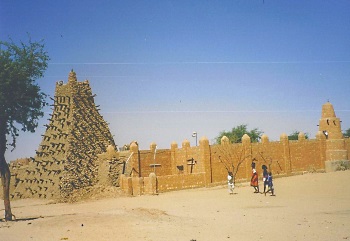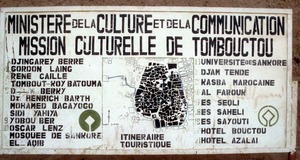Timbuktu

Timbuktu was an important commercial, spiritual and cultural centre on the southern trans-Saharan trading route.
It profited from the booming gold and salt trade in the Sahara region from the 15th century onwards. Housing a famous university, three large mosques and several madrassas, Timbuktu also played an important role in the early spread of Islam in Africa. The inscription actually narrows down to the three large mosques and sixteen cemeteries and mausoleums of Timbuktu. The buildings show traditional characteristic construction techniques.
Community Perspective: those who managed to visit found sand-covered streets and souvenir-selling Touareg. Due to terrorist/kidnapping threats, it nowadays is only accessible by flying in.

Map of Timbuktu
Community Reviews
Eric Lurio
Let's just call it the third pole. Timbuktu was one of those places of legend that it was impossible to get to. That is until the turn of the 19th century, when French and British explorers finally set foot in the place.
Then there was the great disappointment the golden city in the middle of nowhere turned out to be made of adobe and dust. It wasn't even a city, just a largish town with the great river Niger on the one side and the great Sahara desert on the other. The caravans from the salt mines brought the valuable edible rocks to the boats waiting on the river in exchange for other goods.
The glorious city of treasure was a myth, or so it seemed to the west.
The true treasures of Timbuktu are the ancient manuscripts that the locals have preserved since the demise of the great University centuries before, and there is, of course, the river, without which, the town could not exist, and yes, the salt which is brought in trucks and not on camels, and the river irrigates vast rice paddies, which from the air looks extremely strange, a green finger reaching into the desert.
The rice feeds the local population, and the price of salt isn't what it used to be and the Toregs, the tribe indigenous to the area has lost most of their camel's drought and disease, not to mention a rebellion against what was then a dictatorial government a few decades back, The dictatorship fell but the rebellion didn't until the early '90s, when they finally gave up. They've been in decline and would drown their sorrows with music at events called "Takoubelt".
About ten years ago this became more formalized, and thus, around the turn of this century, the Festival of the Desert was born.
What it is, is a cross between 'Lollapalooza' and 'Burning Man' festivals, taking place not in Timbuktu, but in a spot on the desert about a 60 miles to the northwest called Essakane, which is truly the middle of nowhere.
The only way you can get there, if you aren't a fabulously wealthy rock star or industrialist and can travel by helicopter, is to take a 4x4 or jeep from Timbuktu, which has an airport, and just for the festival, Air Mali adds a couple of flights to their twice a week schedule to Mali's capitol of Bamako, via the nicer city of Mopti, just for the festival.
It's possible to take a boat down the Niger or you can take a bus, a trip that lasts a full day of traveling the 350 miles over mostly dirt roads, and what with the State department saying that some Toregs have decided that holding Americans for ransom is a responsible career opportunity-flying is the only option.
Generally, once you get there, you have to take a look at Timbuktu, which is actually a pretty decent town, although the souvenir salesmen will follow you wherever you go throughout your stay, There isn't much there, although the Libyan government is investing a ton of money in the place, building a huge, grand hotel right on northern edge of town, which may or may not be open by 2011.
Once you get to Essakane, the tour company will escort you to your tent, there are no hotels there, and for the next three days you will 'rough it' in a luxurious way. The cream of the Sub-saharan music scene shows up, and it doesn't really matter if you've ever heard of Salif Keita or Ousmane Kouyat or any of the other musicians, they're all really good.
Els Slots

The past of Timbuktu past is more glorious than its present. Now it is a little town on the edge of the Sahara, with sand-covered streets and souvenir selling Toeareg. The mosques are worth a visit, as are the old houses in the center of town with their beautiful manufactured doors.
My most remarkable moment was that when I arrived on Friday afternoon, its male inhabitants with their colourful robes just left the mosques. They made a wonderful contrast with the sandy streets and buildings.
Community Rating
Site Info
Site History
2012 In Danger
threatened by armed conflict & to prevent trafficking in cultural objects from there
2008 Reinforced Monitoring
New constructions near mosques
2005 Removed from Danger list
1990 In Danger
threat of sand encroachment
1988 Inscribed
1981 Deferred
At Bureau - Needs better delimitation etc
1980 Deferred
Site Links
Unesco Website
Related
In the News
Connections
The site has 35 connections
Art and Architecture
Constructions
Damaged
Geography
History
Human Activity
Individual People
Religion and Belief
Science and Technology
Timeline
Trivia
Visiting conditions
WHS Names
WHS on Other Lists
World Heritage Process
Visitors
38 Community Members have visited.
